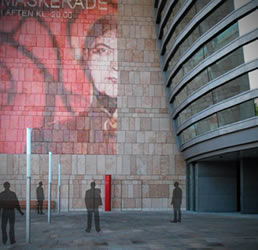Images set in stone for better cities

date: 26/08/2015
Project: Development of an Innovative Digital Con...
acronym: DIGISTONE
See also: CORDIS
Imagine a wall that shows images from nowhere – or a billboard that shrugs off high winds, sharp objects and graffiti. Panels developed by the DIGISTONE project offer a robust, low-waste alternative to traditional LED and LCD outdoor screens, and can be integrated into buildings for a harmonious urban landscape.
The innovative building material shows live electronic images when in operation; when switched off, it leaves a plain surface that can be matched to its surroundings. The specially developed concrete screens protect the electronics and fibre-optic technology inside, while traditional methods can be used to maintain the concrete surface e.g. in case of graffiti.
Project coordinator Lars Nyholm Thrane of the Danish Technological Institute says: “Our screens are much harder to damage than other types of billboard. This means they help maintain an attractive urban environment and are very long-lasting.”
Screens from the two-year DIGISTONE project also save energy and resources compared to existing LED (light-emitting diode)- and LCD (liquid crystal display)-based screens, while keeping many of their advantages, says Bo Jacobsen of Dupont Lightstone, an SME manufacturer and initiator of the project.
As with current LED and LCD billboards, images on the concrete screens are updated remotely, saving resources and cutting waste compared to traditional poster displays. And because the DIGISTONE screens are so resistant to damage and dirt, they need fewer repairs and less cleaning than many LED or LCD screens. They are also more suitable for outdoor signage than LCD screens, which are rarely powerful enough to display good images in sunlight.
Because they can be integrated into walls or street furniture such as bus shelters, the concrete screens also avoid cluttering public spaces, even “disappearing” into the background when not in use, Nyholm Thrane says.
Hopes are high that the project’s innovation could create a new industry and jobs, most of which would be in high-tech SMEs, says Jacobsen.
Lighting the way
At the heart of the team’s technology are very fine “light guides”, explains Jacobsen. Running through the concrete blocks, these polymer optical fibres transmit images from a low-energy custom made LED screen to the surface of a panel.
Because the fibres are down to 1.5mm apart, they transmit very high-resolution images, giving a sharp picture that is visible from one metre away. When the screen is not operating, the ultra-thin fibres are hard to see on the surface, he adds.
To hold the fibres in place, the concrete – designed for the project – is a special fine-grain mix that is strong enough to resist knocks and be cleaned like standard concrete.
Screens use a modular design, made of individual panels which can be fixed in place in different ways, depending on the application. For example, they can be attached to a load-bearing frame.
While the image is on the external wall, the electronics controlling it are on the inside of the wall, protected with a cover. This direct access to components and the modular system are designed to make the screens easy to maintain and repair.
Since the end of the project in October 2014, its seven members have been investigating the business case for commercialising the technology. According to Jacobsen, the screens could create over 900 jobs over five years, based on current production abilities and interest in the technology.
These jobs would be spread between consortium members, sub-contractors and suppliers and would include around 400 high-tech jobs in testing, development, quality control and sales. Initially, jobs would be concentrated in Denmark, Portugal and the UK, but with scope to expand elsewhere, depending on the location of sub-suppliers and licensed producers.
Nyholm Thrane sees the screens being used for many applications. He says: “the first application is for advertising, such as standalone billboards. But at a later stage we will see the screens being integrated into facades, not only for advertising but also as an architectural feature in buildings.”
With less pollution, more attractive streets and walls that are works of art, a concrete jungle could become an urban oasis.
Jacobsen says: “We are concentrating on advertising in Northern Europe for now, because that is where the interest is. But this could benefit a whole range of other industries and regions.”
Below DIGISTONE test screen
© Danish Technological Institute
Read an article about DIGISTONE in Horizon Magazine
